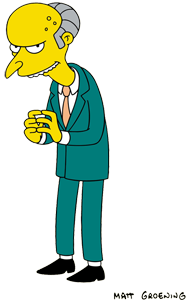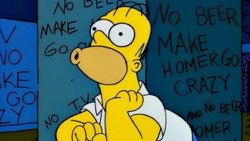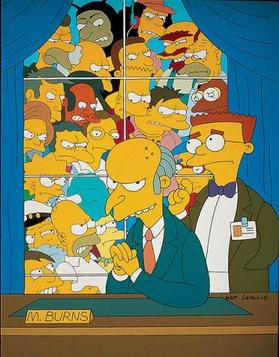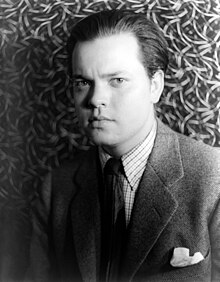
Margaret Lenny "Maggie" Simpson is a fictional character in the animated television series The Simpsons and the youngest member of the Simpson family. She first appeared on television in the Tracey Ullman Show short "Good Night" on April 19, 1987. Maggie was created and designed by cartoonist Matt Groening while he was waiting in the lobby of James L. Brooks' office. She received her first name from Groening's youngest sister. After appearing on The Tracey Ullman Show for three years, the Simpson family was given their own series on the Fox Broadcasting Company which debuted December 17, 1989.

Waylon Joseph Smithers Jr., usually referred to by the names Mr. Smithers, or simply Smithers, is a recurring character in the animated sitcom The Simpsons, voiced by Harry Shearer. His first appearance was in the episode of "Homer's Odyssey", although his voice could be heard in the series premiere "Simpsons Roasting on an Open Fire". He is the consummate executive and personal assistant of Springfield Nuclear Power Plant's owner Mr. Burns, and is usually treated unfairly.

Charles Montgomery Plantagenet Schicklgruber "Monty" Burns, usually referred to as Mr. Burns or C. Montgomery Burns, is a recurring character in the animated television series The Simpsons, voiced initially by Christopher Collins and since by Harry Shearer. He is the mostly evil, devious, greedy, and wealthy owner of the Springfield Nuclear Power Plant and, by extension, Homer Simpson's boss. He is assisted at almost all times by Smithers, his loyal and sycophantic aide, adviser, confidant, and secret admirer. He is between 81 and 120 years old, though sometimes it's implied he's much older.
"There's No Disgrace Like Home" is the fourth episode of the American animated television series The Simpsons. It first aired on the Fox network in the United States on January 28, 1990. In the episode, Homer is ashamed of his family's behavior at a catastrophic company picnic and enrolls them in therapy. The therapist, Dr. Marvin Monroe, struggles to solve their problems − culminating in a shock therapy-based showdown between the family members − before eventually giving up and refunding their money.

"Treehouse of Horror IV" is the fifth episode of the fifth season of the American animated television series The Simpsons and the fourth episode in the Treehouse of Horror series of Halloween specials. It originally aired on the Fox network in the United States on October 28, 1993, and features three short stories called "The Devil and Homer Simpson", "Terror at 5+1⁄2 Feet", and "Bart Simpson's Dracula".
"Treehouse of Horror III" is the fifth episode of the fourth season of the American animated television series The Simpsons. It originally aired on the Fox network in the United States on October 29, 1992. The third annual Treehouse of Horror episode, it features segments in which Homer buys Bart an evil talking doll, Homer is a giant ape which is captured by Mr. Burns in a parody of the 1933 version of King Kong, and Bart and Lisa inadvertently cause zombies to attack Springfield.

"Treehouse of Horror V" is the sixth episode of the sixth season of the American animated television series The Simpsons, and the fifth entry in the Treehouse of Horror series. It originally aired on the Fox network in the United States on October 30, 1994, and features three short stories: "The Shinning", "Time and Punishment", and "Nightmare Cafeteria".
"The Simpsons 138th Episode Spectacular" is the tenth episode of the seventh season of the American animated television series The Simpsons. It originally aired on the Fox network in the United States on December 3, 1995. As the title suggests, it is the 138th episode and the third clip show episode of The Simpsons, after "So It's Come to This: A Simpsons Clip Show" and "Another Simpsons Clip Show".
"Lady Bouvier's Lover" is the twenty-first and penultimate episode of the fifth season of the American animated television series The Simpsons. It originally aired on the Fox network in the United States on May 12, 1994. In the episode, Abe Simpson falls in love with Marge's mother, Jacqueline Bouvier, and they start dating. However, on a night out in town, she is charmed by Mr. Burns. Abe is brokenhearted when he learns that Jacqueline is going to marry Mr. Burns.
"$pringfield ", simply known as "$pringfield", is the tenth episode of the fifth season of the American animated television series The Simpsons, and the 91st episode overall. It originally aired on the Fox network in the United States on December 16, 1993. In the episode, Springfield legalizes gambling to revitalize its economy. Mr. Burns opens a casino where Homer is hired as a blackjack dealer. Marge develops a gambling addiction, Bart opens a casino in his tree house, and Burns' appearance and mental state deteriorate à la Howard Hughes.
"And Maggie Makes Three" is the thirteenth episode of the sixth season of the American animated television series The Simpsons. It originally aired on the Fox network in the United States on January 22, 1995. In the episode, Homer recounts the story of Maggie's birth when Bart and Lisa ask why there are no photos of her in the family album.

"Deep Space Homer" is the fifteenth episode of the fifth season of American animated television series The Simpsons, which was first broadcast on Fox in the United States on February 24, 1994. In the episode, NASA selects Homer Simpson to participate in a spaceflight to spark public interest in space exploration and boost low ratings of the launches. Once in space, his incompetence destroys the navigation system on board the Space Shuttle.

"Homie the Clown" is the fifteenth episode of the sixth season of the American animated television series The Simpsons. It originally aired on the Fox network in the United States on February 12, 1995. In the episode, Homer becomes a Krusty the Clown impersonator, but is mistaken for the real Krusty by the Springfield Mafia. Joe Mantegna returned as Fat Tony, while Dick Cavett and Johnny Unitas guest starred as themselves.
"A Streetcar Named Marge" is the second episode of the fourth season of the American animated television series The Simpsons. It first aired on the Fox network in the United States on October 1, 1992. In the episode, Marge wins the role of Blanche DuBois in a community theatre musical version of Tennessee Williams' A Streetcar Named Desire. Homer offers little support for his wife's acting pursuits, and Marge begins to see parallels between him and Stanley Kowalski, the play's boorish lead male character. The episode contains a subplot in which Maggie Simpson attempts to retrieve her pacifier from a strict daycare owner.
"Two Dozen and One Greyhounds" is the twentieth episode of the sixth season of the American animated television series The Simpsons. It originally aired on the Fox network in the United States on April 9, 1995. The episode was written by Mike Scully and directed by Bob Anderson. Frank Welker guest stars as Santa's Little Helper and various other dogs. In the episode, Santa's Little Helper has puppies with a dog that he met at the greyhound racetrack.
"Burns' Heir" is the eighteenth episode of the fifth season of the American animated television series The Simpsons. It originally aired on the Fox network in the United States on April 14, 1994. In the episode, Mr. Burns has a near-death experience that prompts him to find an heir to inherit his wealth after he dies. He chooses Bart as his heir because he admires the "creature of pure malevolence". Marge convinces Bart to spend time with his benefactor, who allows his heir the money and freedom to do whatever he pleases. Soon Bart leaves his family to live with Burns instead.
Media is a recurring theme of satire on The Simpsons. The show is known for its satire of American popular culture and especially television culture, but has since its inception covered all types of media such as animation, journalism, commercials, comic books, movies, internet, and music. The series centers on a family and their life in a typical American town but the town of Springfield acts as a complete universe. The town features a vast array of media channels—from kids' television programming to local news, which enables the producers to make jokes about themselves and the entertainment industry.

The sixth season of the American animated television series The Simpsons originally aired on the Fox network between September 4, 1994, and May 21, 1995, and consists of 25 episodes. The Simpsons is an animated series about a working class family, which consists of Homer, Marge, Bart, Lisa, and Maggie. The show is set in the fictional city of Springfield, and lampoons American culture, society, television and many aspects of the human condition.

The fifth season of the American animated television series The Simpsons originally aired on the Fox network between September 30, 1993, and May 19, 1994. The showrunner for the fifth production season was David Mirkin who executive produced 20 episodes. Al Jean and Mike Reiss executive produced the remaining two, which were both hold overs that were produced for the previous season. The season contains some of the series' most acclaimed and popular episodes, including "Cape Feare", "Lisa vs. Malibu Stacy", "Homer Goes to College", "Deep Space Homer", and "Rosebud". It also includes the 100th episode, "Sweet Seymour Skinner's Baadasssss Song". The season was nominated for two Primetime Emmy Awards and won an Annie Award for Best Animated Television Program as well as an Environmental Media Award and a Genesis Award. The DVD box set was released in Region 1 on December 21, 2004, Region 2 on March 21, 2005, and Region 4 on March 23, 2005.

"Who Shot Mr. Burns?" is a two-part episode of the American animated television series The Simpsons.Part One is the twenty-fifth and final episode of the sixth season and originally aired on the Fox network in the United States on May 21, 1995, while Part Two is the season premiere of the seventh season and aired on September 17, 1995.











